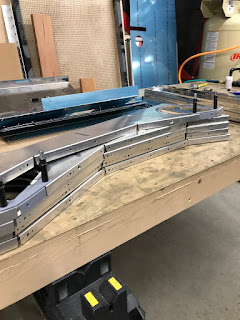One thing that has been on my mind was how to ensure the F-716 rib would be straight so that I could be accurate drilling with me template. What I came up with was to make a second template, but this time made from the seat pan. At least this way I could ensure that the ribs were the right distance apart.


This wood template ends up being placed on the underside of the ribs, and I cleco’d on the pilot seat pan..and began match drilling. First the co-pilot side. Then the pilot side.


When setting the seat pans on the assembly. I didn’t quite like the fit. I need the F-716 ribs to sit tighter to the spar. Took me some time to find it on the plans, but I figured out I need to countersink the spar for the AN426 rivets that eventually attach the F-716 seat ribs. I’ll just insert the rivets for now to help hold things in alignment.


I then moved over to drilling the 1 1/2” hole in the replacement F-725R luggage rib that I received from Vans earlier today. Then I recleco’d the assembly as I will need to re-install the center section bottom skin so I can match drill it.

I cant flip the assembly by myself, so I have to wait for help....

Wanting to keep building, I moved back over to the aileron trim. I dimpled the rear mounting holes for the countersunk screws. Then, I set up the sanding station with the table at 45deg to chamfer the edge of the plastic to allow figment to the mounting bracket.

I could then mark out the final placement of the block, clamped the assembly and match drilled the two mounting holes.

Next I laid out the nutplates and drilled the mounting holes to #40.


















































